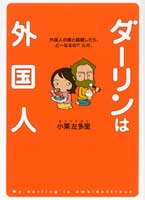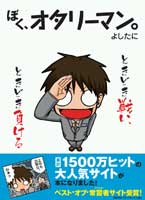Web Japan > Trends in Japan > Pop Culture > Comic Essays Offer Glimpses of Otaku Life
Comic Essays Offer Glimpses of Otaku Life
New Manga Format a Hit with Readers of Both Genders
Over the past several years, a new style of manga known as the "comic essay" has become popular among readers in Japan. This new format features illustrated anecdotes from the authors' everyday lives. Many of the first such works were told from a female standpoint and focused on subjects like marriage and childrearing; their main audience was women in their twenties and thirties. But lately numerous comic essays have appeared that portray the lives of Japan's otaku (anime and manga fanatics). These comics, most of which are written from a male perspective, are becoming increasingly popular with readers of all ages and genders.

The cover of Darling wa gaikokujin (My Darling is a Foreigner) by Oguri Saori.©Oguri Saori / Media Factory
Internet Origins
Over the last few years, comic essays offering humorous depictions of daily life have emerged as a bestselling genre in Japan. One such story is Darling wa gaikokujin (My Darling is a Foreigner), writer and illustrator Oguri Saori's tale of life with her American husband. The series has been a runaway hit since the first volume went on sale in 2002, and the three books in the trilogy have together sold a total of 1.9 million copies. The latest installment in the series, portraying the couple's experiences parenting their newborn baby, debuted in March 2008 and will soon go for a second printing.
In one of the earliest examples of this genre, manga artist Takano Yu recounted her experiences raising her three children in a wildly popular comic essay published in 1998. Portions of the comic have even been published in South Korea - evidence that both in Japan and abroad, current and expectant mothers have connected with Yu's experiences.
Recently the comic essay genre has expanded to include works addressing different themes. Especially popular are manga that tell the story of the everyday lives of otaku. Two of the best-known examples of such works are Tonari no 801-chan (My Neighbor Yaoi) and Boku, otaryman (I Am an Otaryman). (Otaryman is a recently coined word meaning "otaku salaryman.") Kojima Ajiko, the writer and illustrator of Tonari no 801-chan, began posting the comic on his blog in 2006; subsequently it went to print in manga format. Tonari no 801-chan has already been adapted into a live-action drama and an audio CD of the story.
Boku, otaryman, another web comic-turned-manga, was written and illustrated by a web engineer, an otaku salaryman in real life, who goes by the name of Yoshitani. This comic relates the rather self-tormenting tale of an otaryman and his work, love life, and friendships. Since debuting in March 2007, the popular series has sold a total of 840,000 volumes. Yoshitani's latest work, Rikei no hitobito (Science Majors), went on sale in October 2008. In the same self-deprecating vein as the author's previous work, Rikei no hitobito depicts the jobs and lifestyle of meticulous, pedantic, logic-driven men who are clumsy in their relations with the opposite sex.
The Everyday Lives of Otaku
Not all comic essays focused on the daily lives of otaku start out as web comics. Takase Eriko's Rikei-kun (The Science Student) debuted in August 2008. It is the story of an ordinary girl's fascination with her nerdy boyfriend, a science student wrapped up in his computer and his research. Rikei-kun's detached behavior and thought process inspire laughs, yet his girlfriend's tender regard for the calm, faithful science student with a passion for his research leaves readers feeling contented as well as entertained, and the manga has proven a popular addition to the burgeoning market for comic essays. (January 2009)


